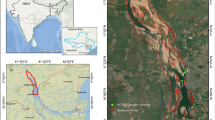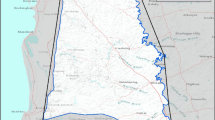Abstract
Mangrove forests in West Asia are pure and sparse to dense communities in contact with high salinity. However, they have been rapidly declining during the previous two decades. What is critical to understanding the growth of mangrove species and better assessing the value of their ecological services is the knowledge gained about mangrove mapping. Since mangrove forests grow primarily in tropical and subtropical regions, and in these areas, the sky is usually cloudy, we used a combination of Sentinel-1 and Sentinel-2. A random forest algorithm is used to investigate the potential of Sentinel images for the extraction of mangrove forests in southern Iran, and seven spectral indices were used for better monitoring of mangrove forests. Our research was focused on three questions: (1) For mangrove forests mapping, whether Sentinel imagery, Sentinel-1 SAR data, or Sentinel-2 multispectral data, is more accurate; (2) which Sentinel imaging feature combination produces the best appropriate mangrove forests map; (3) how does a 10-m resolution map increase our understanding of the distribution of mangrove forests when compared to 30-m resolution mangrove products obtained from Landsat imagery? This study showed that the Sentinel-2 time-series images with an F1-score (0.89) are more effective in extracting the mangrove map than the Sentinel-1 time-series images with an F1-score (0.83). According to this study, it can be stated that the combination of multispectral and SAR images had an acceptable performance in separating areas with an area of less than 1 hectare of mangrove forests.






Similar content being viewed by others
References
Abburu S, Babu Golla S (2015) Satellite image classification methods and techniques: a review. Int J Comput Appl. https://doi.org/10.5120/21088-3779
Akhrianti I (2019) Spatial distribution of mangrove in Kelapan Island. Regency, South Bangka
Atwood TB, Connolly RM, Almahasheer H et al (2017) Global patterns in mangrove soil carbon stocks and losses. Nat Clim Chang. https://doi.org/10.1038/nclimate3326
Azmat A, Kazmi JH, Shahzad A, Shaikh S (2020) Mapping change in spatial extent and density of mangrove forests at Karachi Coast using object based image analysis. Int J Econ Environ Geol. https://doi.org/10.46660/ojs.v11i1.423
Badusha AMAA, Mohideen SK (2021) A hybrid ACO based optimized RVM Algorithm for land cover satellite image classification. EAI Endorsed Trans Energy Web. https://doi.org/10.4108/eai.23-12-2020.167789
Belgiu M, Drăgu L (2016) Random forest in remote sensing: a review of applications and future directions. In ISPRSISPRS J Photogramm Remote Sens 114:24–31. https://doi.org/10.1016/j.isprsjprs.2016.01.011
Camisón C, Villar-López A (2014) Organizational innovation as an enabler of technological innovation capabilities and firm performance. J Bus Res. https://doi.org/10.1016/j.jbusres.2012.06.004
Castillo JAA, Apan AA, Maraseni TN, Salmo SG (2017) Estimation and mapping of above-ground biomass of mangrove forests and their replacement land uses in the Philippines using Sentinel imagery. ISPRS J Photogramm Remote Sens. https://doi.org/10.1016/j.isprsjprs.2017.10.016
Chauhan S, Darvishzadeh R, Lu Y et al (2020) Understanding wheat lodging using multi-temporal Sentinel-1 and Sentinel-2 data. Remote Sens Environ. https://doi.org/10.1016/j.rse.2020.111804
De Alban JDT, Jamaludin J, Wong De Wen D et al (2020) Improved estimates of mangrove cover and change reveal catastrophic deforestation in Myanmar. Environ Res Lett. https://doi.org/10.1088/1748-9326/ab666d
Dhingra S, Kumar D (2019) A review of remotely sensed satellite image classification. Int J Electr Comput Eng:1720–1731. https://doi.org/10.11591/ijece.v9i3
Felegari S, Sharifi A, Moravej K et al (2021) Integration of Sentinel 1 and Sentinel 2 satellite images for crop mapping. Appl Sci. https://doi.org/10.3390/app112110104
Friess DA, Rogers K, Lovelock CE et al (2019) The State of the world’s mangrove forests: past, present, and future. Annu Rev Environ Resour. https://doi.org/10.1146/annurev-environ-101718-033302
Gao BC (1996) NDWI - a normalized difference water index for remote sensing of vegetation liquid water from space. Remote Sens Environ. https://doi.org/10.1016/S0034-4257(96)00067-3
Ghaderizadeh S, Abbasi-Moghadam D, Sharifi A et al (2021) Hyperspectral image classification using a hybrid 3D-2D convolutional neural networks. IEEE J Sel Top Appl Earth Obs Remote Sens. https://doi.org/10.1109/JSTARS.2021.3099118
Ghasemi S, Javid AH, Farsad F et al (2021) An evaluation of the marine environmental resilience to the north of Qeshm Island. Environ Monit Assess. https://doi.org/10.1007/s10661-021-09627-5
Ghorbanian A, Zaghian S, Asiyabi RM et al (2021) Mangrove ecosystems mapping using Sentinel-1 and Sentinel-2 satellite images and random forest algorithm in google earth engine. Remote Sens. https://doi.org/10.3390/rs13132565
Hill MJ (2013) Vegetation index suites as indicators of vegetation state in grassland and savanna: an analysis with simulated SENTINEL 2 data for a North American transect. Remote Sens Environ. https://doi.org/10.1016/j.rse.2013.06.004
Hu L, Li W, Xu B (2018) Monitoring mangrove forests change in China from 1990 to 2015 using Landsat-derived spectral-temporal variability metrics. Int J Appl Earth Obs Geoinf. https://doi.org/10.1016/j.jag.2018.04.001
Hu P, Sharifi A, Tahir MN et al (2021) Evaluation of vegetation indices and phenological metrics using time-series modis data for monitoring vegetation change in Punjab. Pakistan Water (Switzerland). https://doi.org/10.3390/w13182550
Hurskainen P, Adhikari H, Siljander M et al (2019) Auxiliary datasets improve accuracy of object-based land use/land cover classification in heterogeneous savanna landscapes. Remote Sens Environ. https://doi.org/10.1016/j.rse.2019.111354
Jia M, Wang Z, Wang C, Mao D, Zhang Y (2019) A new vegetation index to detect periodically submerged mangrove forest using single-tide Sentinel-2 imagery. Remote Sens 11(17). https://doi.org/10.3390/rs11172043
Jia SL, Chi Z, Liu GL, et al (2020) Fungi in mangrove ecosystems and their potential applications. Crit. Rev. Biotechnol
Karydas C, Bouarour O, Zdruli P (2020) Mapping spatio-temporal soil erosion patterns in the Candelaro River Basin, Italy, using the G2 model with Sentinel2 imagery. Geosci. https://doi.org/10.3390/geosciences10030089
Kaur A, Sachdeva K, Rani V (2017) A review on satellite image classification. Int J Comput Sci Information Technol 11(1)
Kumar L, Mutanga O (2018) Google Earth Engine applications since inception: usage, trends, and potential. Remote Sens. https://doi.org/10.3390/rs10101509
Li H, Han Y, Chen J (2020) Combination of Google Earth imagery and Sentinel-2 data for mangrove species mapping. J Appl Remote Sens. https://doi.org/10.1117/1.jrs.14.010501
Mazraeh HM, Pazhouhanfar M (2018) Effects of vernacular architecture structure on urban sustainability case study: Qeshm Island. Iran Front Archit Res. https://doi.org/10.1016/j.foar.2017.06.006
Mondal B, Saha AK, Roy A (2021) Spatio-temporal pattern of change in mangrove populations along the coastal West Bengal. Environ Challenges, India. https://doi.org/10.1016/j.envc.2021.100306
Moradi E, Sharifi A (2022) Assessment of forest cover changes using multi-temporal Landsat observation. Environ Dev Sustain. https://doi.org/10.1007/s10668-021-02097-2
Mursyid H, Daulay MH, Pratama AA, Laraswati D, Novita N, Malik A, Maryudi A (2021) Governance issues related to the management and conservation of mangrove ecosystems to support climate change mitigation actions in Indonesia. In Forest Policy Econ 133. https://doi.org/10.1016/j.forpol.2021.102622
Osland MJ, Enwright NM, Day RH, et al (2016) Beyond just sea-level rise: considering macroclimatic drivers within coastal wetland vulnerability assessments to climate change. Glob. Chang. Biol
Robertson AI, Daniel PA, Dixon P (1991) Mangrove forests structure and productivity in the Fly River estuary, Papua New Guinea. Mar Biol. https://doi.org/10.1007/BF01986356
Ronoud G, Fatehi P, Darvishsefat AA et al (2021) Multi-sensor aboveground biomass estimation in the broadleaved Hyrcanian forest of Iran. Can J Remote Sens. https://doi.org/10.1080/07038992.2021.1968811
Sagawa T, Yamashita Y, Okumura T, Yamanokuchi T (2019) Satellite derived bathymetry using machine learning and multi-temporal satellite images. Remote Sens. https://doi.org/10.3390/rs11101155
Sekulić A, Kilibarda M, Heuvelink GBM et al (2020) Random forest spatial interpolation. Remote Sens. https://doi.org/10.3390/rs12101687
Shafaey MA, Salem MAM, Ebied HM, Al-Berry MN, Tolba MF (2019) Deep Learning for Satellite Image Classification. Adv Intell Sys Comput 845:383–391. https://doi.org/10.1007/978-3-319-99010-1_35
Sidik F, Supriyanto B, Krisnawati H, Muttaqin MZ (2018) Mangrove conservation for climate change mitigation in Indonesia. In Wiley interdisciplinary reviews: Clim Chang 9(5). https://doi.org/10.1002/wcc.529
Tan FL, Ye GF, Cui LJ et al (2010) Site type classification of mongrove in Quanzhou estuary wetlands. Wetl Sci 8:366–370
Tariq A, Shu H, Siddiqui S et al (2022) Spatio-temporal analysis of forest fire events in the Margalla Hills, Islamabad, Pakistan using socio-economic and environmental variable data with machine learning methods. J For Res. https://doi.org/10.1007/s11676-021-01354-4
Thiagarajan K, Anandan MM, Stateczny A et al (2021) Satellite image classification using a hierarchical ensemble learning and correlation coefficient-based gravitational search algorithm. Remote Sens. https://doi.org/10.3390/rs13214351
Toosi NB, Soffianian AR, Fakheran S, Waser LT (2022) Mapping disturbance in mangrove ecosystems: incorporating landscape metrics and PCA-based spatial analysis. Ecol Indic. https://doi.org/10.1016/j.ecolind.2022.108718
Tucker CJ (1979) Red and photographic infrared linear combinations for monitoring vegetation. Remote Sens Environ. https://doi.org/10.1016/0034-4257(79)90013-0
Twilley RR, Rovai AS, Riul P (2018) Coastal morphology explains global blue carbon distributions. Front Ecol Environ. https://doi.org/10.1002/fee.1937
Vaiphasa C, Ongsomwang S, Vaiphasa T, Skidmore AK (2005) Tropical mangrove species discrimination using hyperspectral data: a laboratory study. Estuar Coast Shelf Sci. https://doi.org/10.1016/j.ecss.2005.06.014
Van der Stocken T, Carroll D, Menemenlis D et al (2019) Global-scale dispersal and connectivity in mangroves. Proc Natl Acad Sci USA. https://doi.org/10.1073/pnas.1812470116
Wachid MN, Hapsara RP, Cahyo RD, Wahyu GN, Syarif AM, Umarhadi DA, Fitriani AN, Ramadhanningrum DP, Widyatmanti W (2017) Mangrove canopy density analysis using Sentinel-2A imagery satellite data. IOP conference series: Earth Environ Sci 70(1). https://doi.org/10.1088/1755-1315/70/1/012020
Wessel M, Brandmeier M, Tiede D (2018) Evaluation of different machine learning algorithms for scalable classification of tree types and tree species based on Sentinel-2 data. Remote Sens. https://doi.org/10.3390/rs10091419
Xu H (2006) Modification of normalised difference water index (NDWI) to enhance open water features in remotely sensed imagery. Int J Remote Sens. https://doi.org/10.1080/01431160600589179
Zhang W, Brandt M, Wang Q et al (2019) From woody cover to woody canopies: how Sentinel-1 and Sentinel-2 data advance the mapping of woody plants in savannas. Remote Sens Environ. https://doi.org/10.1016/j.rse.2019.111465
Funding
This work was supported by Shahid Rajaee Teacher Training University under contract number 19059.
Author information
Authors and Affiliations
Corresponding author
Ethics declarations
Conflict of interest
The authors declare that they have competing interests.
Additional information
Responsible Editor: Biswajeet Pradhan
Rights and permissions
Springer Nature or its licensor holds exclusive rights to this article under a publishing agreement with the author(s) or other rightsholder(s); author self-archiving of the accepted manuscript version of this article is solely governed by the terms of such publishing agreement and applicable law.
About this article
Cite this article
Sharifi, A., Felegari, S. & Tariq, A. Mangrove forests mapping using Sentinel-1 and Sentinel-2 satellite images. Arab J Geosci 15, 1593 (2022). https://doi.org/10.1007/s12517-022-10867-z
Received:
Accepted:
Published:
DOI: https://doi.org/10.1007/s12517-022-10867-z




